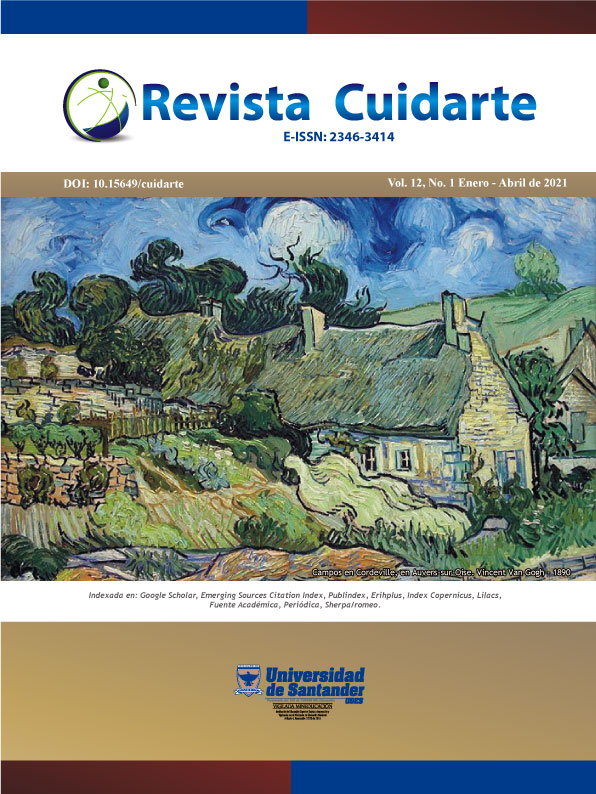Potential inactivation of SARS-CoV2 coronavirus: which germicidal agents are proposed?
DOI:
https://doi.org/10.15649/cuidarte.1273Keywords:
SARS-CoV2, Anti-Bacterial Agents, Virus InactivationAbstract
Coronavirus 2019 disease (COVID-19), an acute respiratory condition caused by SARS-CoV2, has been classified as a pandemic by the World Health Organization (WHO) once it has spread to 215 countries around the world, infecting more than 7.8 million people and causing nearly 440,000 deaths1.
SARS-CoV2 is a coronavirus type β with genomic characteristics similar to MERS-CoV and SARS-CoV1 which affected more than 10,000 people in the last two decades2,3. Due to the high rate of infection and spread of SARS-CoV2, several mitigation measures have been employed. Measures adopted include quarantine, physical distancing, cleaning of surfaces and aerosols, and the use of personal protective equipment (PPE)2-6
Since sufficiently effective vaccine and treatments are not available, preventing infection by direct contact with surfaces, aerosols, or suspensions contaminated with SARS-CoV2 is the first and most important measure of containment against the pandemic.7 This is because SARS-CoV2 can survive for 3 hours in aerosols, 4 hours on copper surfaces, one day on cardboard, two days on stainless steel, and up to 3 days on plastic8. Given the high demand for PPE, which causes shortages and forces the reuse of PPE7,9 , effective cleaning methods are crucial.
How to cite this article: Wilches Visbal Jorge Homero, Castillo Pedraza Midian Clara, Serpa Romero Xiomara Zilena. Inactivación potencial del coronavirus SARS-CoV2: ¿qué agentes germicidas se proponen?. Revista Cuidarte. 2021;12(1):e1273. http://dx.doi.org/10.15649/cuidarte.1273
References
Colombia. Ministerio de Salud y Protección Social. Reporte Mundial y Nacional de Casos por COVID-19 [Internet]. 2020 [citado 16 de junio de 2020]. Disponible en: https://twitter.com/MinSaludCol/status/1272648258435891202
Fernandez D, Alonso LM, Fernández JA, Ordás B MS. Todo lo que necesitas saber del Coronavirus. Tiempos enfermería y salud [Internet]. 2019;2(7):1-10. Disponible en: https://tiemposdeenfermeriaysalud.es/journal/article/view/73/60
Fallahi HR, Keyhan SO, Zandian D, Kim S-G, Cheshmi B. Being a front-line dentist during the Covid-19 pandemic: a literature review. Maxillofac Plast Reconstr Surg. 2020;42(1):1-9. https://doi.org/10.1186/s40902-020-00256-5
Güner R, Hasanoğlu İ, Aktaş F. Covid-19: Prevention and control measures in community. Turkish J Med Sci. 2020;50(SI-1):571-7. https://doi.org/10.3906/sag-2004-146
Peng X, Xu X, Li Y, Cheng L, Zhou X, Ren B. Transmission routes of 2019-nCoV and controls in dental practice. Int J Oral Sci [Internet]. 3 de diciembre de 2020;12(1):1-9. https://doi.org/10.1038/s41368-020-0075-9
Balachandar V, Mahalaxmi I, Kaavya J, Vivekanandhan G, Ajithkumar S, Arul N, et al. COVID-19: Emerging protective measures. Eur Rev Med Pharmacol Sci. 2020;24(6):3422-5.
Kampf G, Todt D, Pfaender S, Steinmann E. Persistence of coronaviruses on inanimate surfaces and their inactivation with biocidal agents. J Hosp Infect [Internet]. 2020;104(3):246-51. https://doi.org/10.1016/j.jhin.2020.01.022
Van Doremalen N, Bushmaker T, Morris DH, Holbrook MG, Gamble A, Williamson BN, et al. Aerosol and Surface Stability of SARS-CoV-2 as Compared with SARS-CoV-1 [Internet]. The New England journal of medicine. 2020. p. 1-4. https://doi.org/10.1101/2020.03.09.20033217
Center for Disease Control and Prevention (CDC). Recommended Guidance for Extended Use and Limited Reuse of N95 Filtering Facepiece Respirators in Healthcare Settings [Internet]. 2020 [citado 16 de junio de 2020]. Disponible en: https://www.cdc.gov/niosh/topics/hcwcontrols/recommendedguidanceextuse.html
Kampf G, Voss A, Scheithauer S. Inactivation of coronaviruses by heat. J Hosp Infect [Internet]. Disponible en: https://www.journalofhospitalinfection.com/article/S0195-6701(20)30124-9/fulltext
Welch D, Buonanno M, Grilj V, Shuryak I, Crickmore C, Bigelow AW, et al. Far-UVC light: A new tool to control the spread of airborne-mediated microbial diseases. Sci Rep [Internet]. 2018;8(1):1-7. https://doi.org/10.1038/s41598-018-21058-w
Buonanno M, Welch D, Shuryak I, Brenner DJ. Far-UVC light efficiently and safely inactivates airborne human coronaviruses. Res Sq [Internet]. 2020. https://doi.org/10.21203/rs.3.rs-25728/v1
Theory Division CCLRI, Card KJ, Crozier D, Dhawan A, Dinh M, Dolson E, et al. UV Sterilization of Personal Protective Equipment with Idle Laboratory Biosafety Cabinets During the Covid-19 Pandemic. medRxiv [Internet]. 2020;2020.03.25.20043489. Disponible en: https://www.medrxiv.org/content/10.1101/2020.03.25.20043489v1%0Ainternal-pdf://0.0.23.4/2020.03.25.html
Center for Disease Control and Prevention (CDC). Use of Cloth Face Coverings to Help Slow the Spread of COVID-19 [Internet]. 2020 [citado 16 de junio de 2020]. Disponible en: https://espanol.cdc.gov/coronavirus/2019-ncov/prevent-getting-sick/cloth-face-cover.html?fbclid=IwAR0yZorXdc1BAEcG9kPErLFzTvr1_CAtdwcdajQ5STizoz9r8qT1wqorG3E
U.S. Food and Drug Administration (FDA). Surgical Mask and Gown Conservation Strategies - Letter to Health Care Providers [Internet]. 2020 [citado 16 de junio de 2020]. Disponible en: https://www.fda.gov/medical-devices/letters-health-care-providers/surgical-mask-and-gown-conservation-strategies-letter-health-care-providers
International Atomic Energy Agency (IAEA). Radiation Effective in Sterilizing Personal Protective Equipment Except For Respiratory Masks [Internet]. 2020 [citado 17 de mayo de 2020]. Disponible en: https://www.iaea.org/newscenter/pressreleases/radiation-effective-in-sterilizing-personal-protective-equipment-except-for-respiratory-masks-iaea
Pastorino B, Touret F, Gilles M, Lamballerie X De, Charrel RN. Evaluation of heating and chemical protocols for inactivating SARS-CoV-2. bioRxiv [Internet]. 2020;0-8. https://doi.org/10.1101/2020.04.11.036855
Downloads
Published
How to Cite
Downloads
License
Journal Cuidarte, scientific publication of open access, is licensed under a Creative Commons Attribution (CC BY-NC), which permits use, distribution and reproduction in any medium, provided the original work is properly cited and is not used for commercial purposes.
Any other form of use such as reproduction, transformation, public communication or distribution, for profit, requires the prior authorization of the University of Santander UDES.
The names and e-mail addresses entered in the Journal Cuidarte will be used exclusively for the purposes stated by this magazine and will not be available for any other purpose or other person.
The articles published in the Journal Cuidarte represent the criteria of their authors and do not necessarily constitute the official opinion of the University of Santander UDES.




